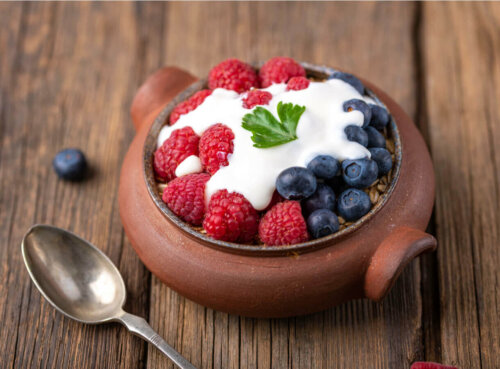3 Types of Healthy Foods

Many people think that coming up with a balanced and varied diet is very easy, little do they know how tough it can really be. For the body to function properly, it’s necessary to maintain a series of appropriate habits. For this reason, in this article, we’ll be presenting the types of healthy foods that you can include in your meals to favor your overall health.
Now, we love that you take our recommendations into account. However, you must remember that paying the nutritionist a visit is important as well, as they’re the ones who will truly know exactly what you need. Additionally, they’ll be able to make a menu adapted to your needs, whether you’re healthy or if you suffer from any pathology.
Also, the nutritional requirements for athletes may be different so it’s even more necessary for them to consult a medical professional when it comes to their diets.
Three types of healthy foods
By including these three types of healthy foods in your diet, you’ll improve the functioning of the physiological reactions that go on in your body. In this way, the feeling of vitality will also increase. Take a look!
1. Fermented dairy
Including dairy in your diet is of extreme importance. There are many dairy products that undergo a previous fermentation process. The most frequently consumed among those are yogurt and kefir.
These foods are capable of providing beneficial probiotics for health. Probiotics are living microorganisms that reach the intestine with the ability to exert a function on it and colonize it.
In fact, there’s plenty of scientific evidence that affirms that consuming these types of products on a frequent basis can improve and prevent intestinal problems, such as inflammatory diseases.
However, it’s vital to note that not all fermented products are healthy. When choosing them, it’s important to read the label. Avoid those that contain added sugars in their composition, as this ingredient reduces the quality of the product.

2. Bluefish
Recently, dietary trends point towards increasing the consumption of fish compared to meat. Two things come from this change. First off, there’s a significant reduction in the total calories in the diet. Secondly, high-quality protein intake is guaranteed.
Among fish, it’s possible to make a differentiation between two major groups: whitefish and bluefish. The latter has are greatly nutritional thanks to its content of unsaturated fatty acids.
These nutrients have plenty of functions in the body. On one hand, they modulate systemic inflammation. On the other hand, and according to a review published in The Cochrane Database of Systematic Reviews, they’re capable of reducing the risk of developing cardiovascular-type pathologies, such as heart attacks.
In addition, several pieces of research state that this type of lipid helps to ensure the maintenance of muscle mass within the framework of a hypocaloric diet. Because of this, it could have an anti-catabolic effect.
3. Red vegetables
We’re sure that everyone (or most people) is aware of the importance of consuming vegetables regularly. However, it’s important to learn the difference between all the different kinds of vegetables. Believe it or not, there are significant distinctions regarding their nutrient content and the benefits they provide.
You may not know this but the greatest characteristic of red vegetables is their high phytonutrient content. These substances are usually pigments (responsible for providing bright colors) and have a high antioxidant capacity.
For example, blueberries, cherries, or tomatoes. The latter contains a nutrient called lycopene, which has been shown to be effective in preventing cardiovascular problems. For this reason, you should consume them on a regular basis.

Healthy foods make up a balanced diet
You can significantly improve the quality of your diet with the three types of healthy foods we mentioned here. However, only consuming these foods isn’t enough. When it comes to ensuring a correct state of health, it’s necessary to take up other important habits, such as exercising on a regular basis.
Likewise, getting a good night’s sleep will also contribute to increasing the efficiency of the physiological reactions that occur daily in the body. Again, don’t hesitate to consult a nutritionist if you have any further questions regarding food. Remember that they’re the ones in charge of analyzing exactly what your body needs in terms of food and developing a personalized plan catered to your requirements.
Many people think that coming up with a balanced and varied diet is very easy, little do they know how tough it can really be. For the body to function properly, it’s necessary to maintain a series of appropriate habits. For this reason, in this article, we’ll be presenting the types of healthy foods that you can include in your meals to favor your overall health.
Now, we love that you take our recommendations into account. However, you must remember that paying the nutritionist a visit is important as well, as they’re the ones who will truly know exactly what you need. Additionally, they’ll be able to make a menu adapted to your needs, whether you’re healthy or if you suffer from any pathology.
Also, the nutritional requirements for athletes may be different so it’s even more necessary for them to consult a medical professional when it comes to their diets.
Three types of healthy foods
By including these three types of healthy foods in your diet, you’ll improve the functioning of the physiological reactions that go on in your body. In this way, the feeling of vitality will also increase. Take a look!
1. Fermented dairy
Including dairy in your diet is of extreme importance. There are many dairy products that undergo a previous fermentation process. The most frequently consumed among those are yogurt and kefir.
These foods are capable of providing beneficial probiotics for health. Probiotics are living microorganisms that reach the intestine with the ability to exert a function on it and colonize it.
In fact, there’s plenty of scientific evidence that affirms that consuming these types of products on a frequent basis can improve and prevent intestinal problems, such as inflammatory diseases.
However, it’s vital to note that not all fermented products are healthy. When choosing them, it’s important to read the label. Avoid those that contain added sugars in their composition, as this ingredient reduces the quality of the product.

2. Bluefish
Recently, dietary trends point towards increasing the consumption of fish compared to meat. Two things come from this change. First off, there’s a significant reduction in the total calories in the diet. Secondly, high-quality protein intake is guaranteed.
Among fish, it’s possible to make a differentiation between two major groups: whitefish and bluefish. The latter has are greatly nutritional thanks to its content of unsaturated fatty acids.
These nutrients have plenty of functions in the body. On one hand, they modulate systemic inflammation. On the other hand, and according to a review published in The Cochrane Database of Systematic Reviews, they’re capable of reducing the risk of developing cardiovascular-type pathologies, such as heart attacks.
In addition, several pieces of research state that this type of lipid helps to ensure the maintenance of muscle mass within the framework of a hypocaloric diet. Because of this, it could have an anti-catabolic effect.
3. Red vegetables
We’re sure that everyone (or most people) is aware of the importance of consuming vegetables regularly. However, it’s important to learn the difference between all the different kinds of vegetables. Believe it or not, there are significant distinctions regarding their nutrient content and the benefits they provide.
You may not know this but the greatest characteristic of red vegetables is their high phytonutrient content. These substances are usually pigments (responsible for providing bright colors) and have a high antioxidant capacity.
For example, blueberries, cherries, or tomatoes. The latter contains a nutrient called lycopene, which has been shown to be effective in preventing cardiovascular problems. For this reason, you should consume them on a regular basis.

Healthy foods make up a balanced diet
You can significantly improve the quality of your diet with the three types of healthy foods we mentioned here. However, only consuming these foods isn’t enough. When it comes to ensuring a correct state of health, it’s necessary to take up other important habits, such as exercising on a regular basis.
Likewise, getting a good night’s sleep will also contribute to increasing the efficiency of the physiological reactions that occur daily in the body. Again, don’t hesitate to consult a nutritionist if you have any further questions regarding food. Remember that they’re the ones in charge of analyzing exactly what your body needs in terms of food and developing a personalized plan catered to your requirements.
All cited sources were thoroughly reviewed by our team to ensure their quality, reliability, currency, and validity. The bibliography of this article was considered reliable and of academic or scientific accuracy.
- Sánchez B., Delgado S., Blanco Míguez A., Lourenço A., et al., Probiotics, gut microbiota and their influence on host health and disease. Mol Nutr Food Res, 2017.
- Abdelhamid AS., Brown TJ., Brainard JS., Biswas P., et al., Omega 3 fatty acids for the primary and secondary prevention of cardiovascular disease. Cochrane Database Syst Rev, 2018.
- Cheng HM., Koutsidis G., Lodge JK., Ashor A., et al., Tomato and lycopene supplementation and cardiovascular risk factors: a systematic review and meta analysis. Ahterosclerosis, 2017. 257: 100-108.
This text is provided for informational purposes only and does not replace consultation with a professional. If in doubt, consult your specialist.








